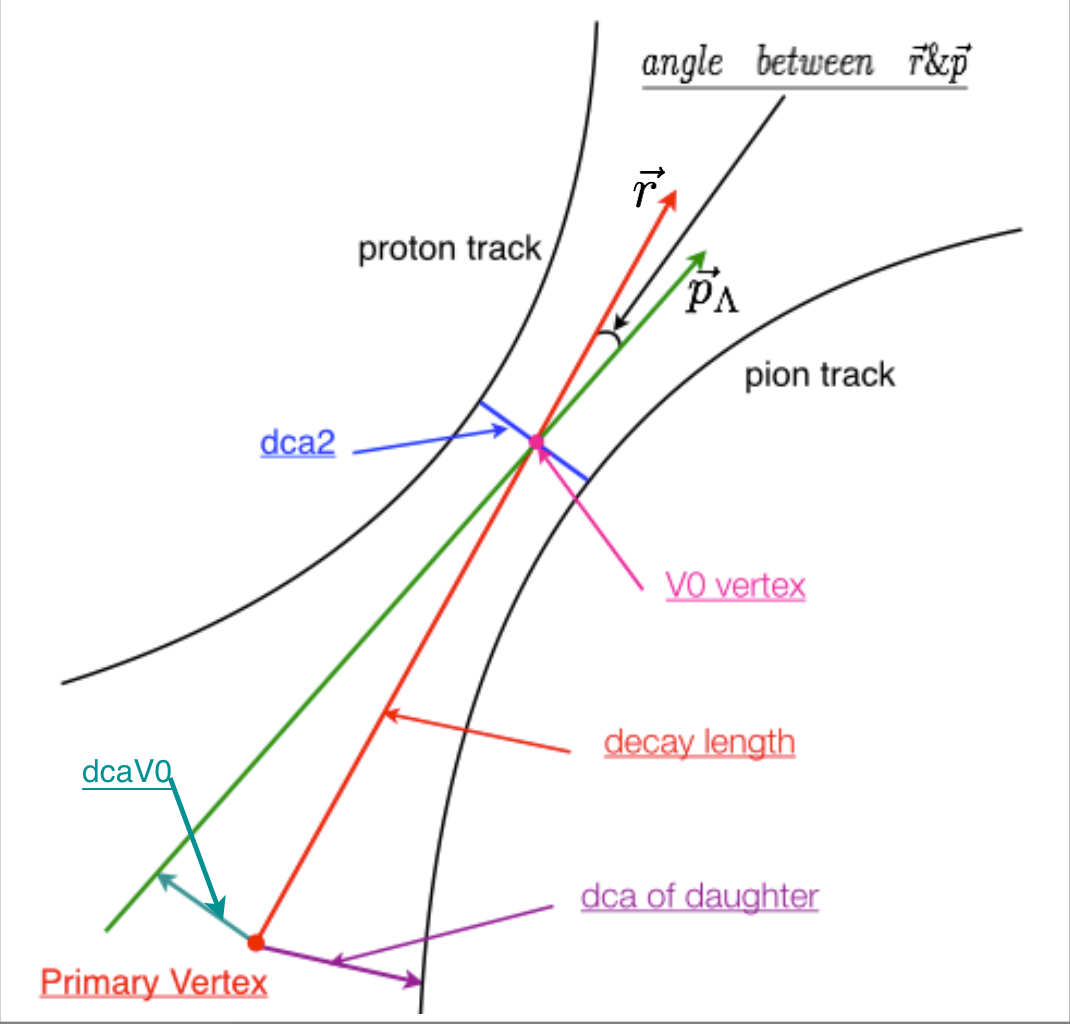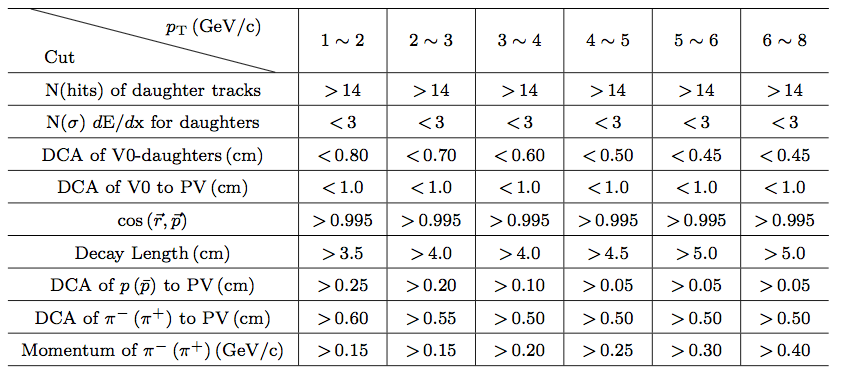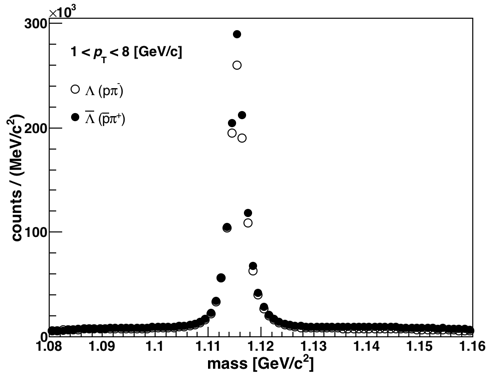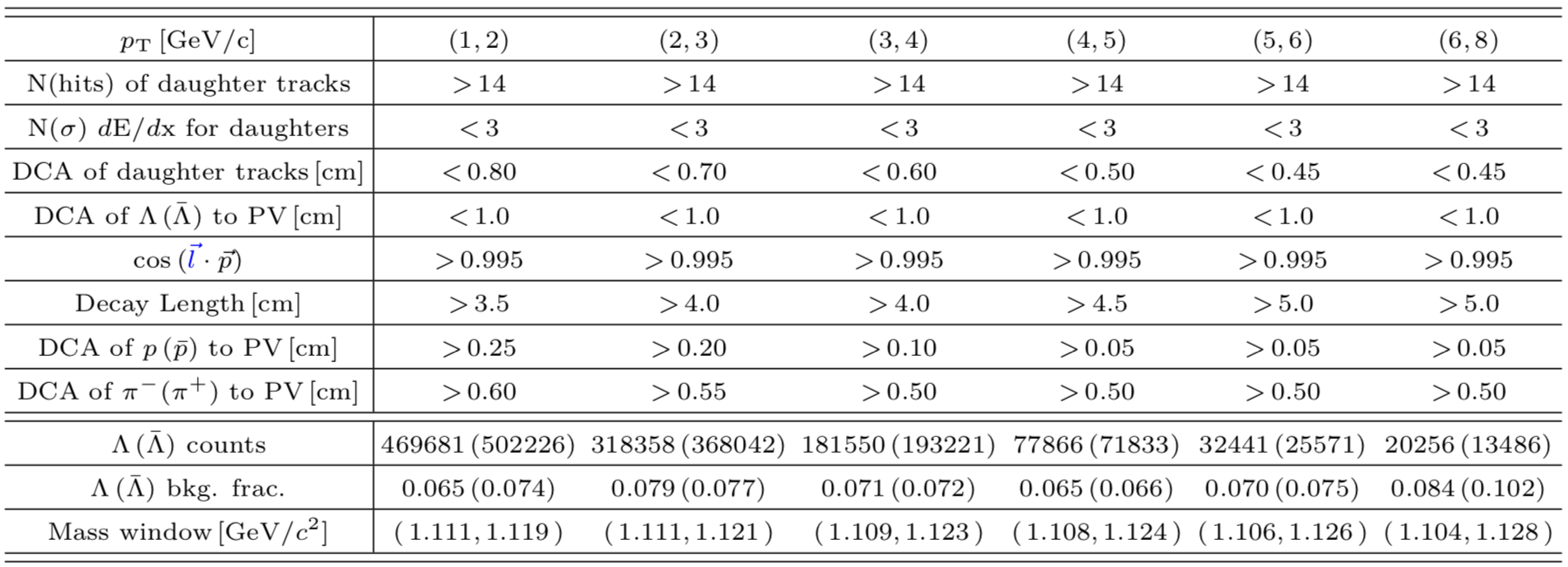2012 Lambda D_TT @200GeV
Web links:
- Lambda reconstruction status
2, Statistics of Lambda and anti-Lambda Reconstruction, Jet near-side
- MC production and data comparison
2, MC and data comparison for inclusive hyperons
3, MC and data comparison for jet near-side hyperons
- Trigger Bias
1, Trigger bias parameters (fz_shift, feed-down fraction, fragmenting parton flavor fraction, subprocess fraction) plots
2, Uncertainty to D_TT from trigger bias
Presentations:
- DIS17
- SPIN2016
- May 16, 2017 Collaboration Meeting, Update of the systematic uncertainty
- Sep. 19, 2016 spinpwg meeting, Preliminary result request
1) Dataset and RunQA
Dataset for pp200trans_2012 D_TT analysis
Statistics Summary
Dataset: pp200trans_2012
Integrated Luminosity: 18.4 pb^-1
Selected Triggers: JP0, JP1, JP2, AJP
Event Statistics For Each Trigger:
| Trigger | JP0 | JP1 | JP2 | AJP | Combined |
|---|---|---|---|---|---|
| HardXSoft | 2.461964e+07 | 8.525444e+07 | 1.797188e+07 | 1.391969e+07 | 1.417656e+08 |
Data QA
2) Lambda Reconstruction
The reconstruction of Lambda and anti-Lambda hyperons.
Identification cut on track’s dE/dx measured in TPC is used to find pion and (anti-)proton.
Sketch for Topological Cuts

Values:

a) Statistics of Lambda and anti-Lambda Reconstruction, Inclusive
b) Statistics of Lambda and anti-Lambda Reconstruction, Jet near-side
Only the jet near-side Lambda used to extract D_TT.
The comparison about the reconstruction status with two sets of cut are shown here.
The loose one is the cut set used in run09 D_LL analysis and the tight one.
a) Statistics of Lambda and anti-Lambda Reconstruction, Inclusive
D_TT analysis Record, Rec_Step: all_cut_crp0995
Invariant Mass
Statistics Summary
====> Lambda
| 1~2 | 1.1154 | 0.0016 | 364262 | 0.0536 | 1.1155 | 0.0016 | 1394859 | 0.0570 | 1.1155 | 0.0016 | 280707 | 0.0666 | 1.1155 | 0.0016 | 338322 | 0.0546 | 1.1155 | 0.0016 | 2378150 | 0.0572 |
| 2~3 | 1.1157 | 0.0021 | 96583 | 0.0609 | 1.1157 | 0.0021 | 496180 | 0.0654 | 1.1157 | 0.0022 | 122363 | 0.0758 | 1.1157 | 0.0021 | 118569 | 0.0631 | 1.1157 | 0.0021 | 833695 | 0.0660 |
| 3~4 | 1.1158 | 0.0027 | 25879 | 0.0612 | 1.1158 | 0.0028 | 186321 | 0.0649 | 1.1158 | 0.0028 | 57674 | 0.0748 | 1.1158 | 0.0027 | 38191 | 0.0609 | 1.1158 | 0.0028 | 308065 | 0.0659 |
| 4~5 | 1.1161 | 0.0035 | 6360 | 0.0616 | 1.1160 | 0.0034 | 65638 | 0.0644 | 1.1159 | 0.0034 | 25367 | 0.0703 | 1.1160 | 0.0035 | 11204 | 0.0565 | 1.1160 | 0.0034 | 108569 | 0.0648 |
| 5~6 | 1.1162 | 0.0041 | 1782 | 0.0791 | 1.1162 | 0.0042 | 25415 | 0.0720 | 1.1162 | 0.0042 | 11736 | 0.0745 | 1.1163 | 0.0042 | 3484 | 0.0669 | 1.1162 | 0.0042 | 42417 | 0.0726 |
| 6~8 | 1.1168 | 0.0051 | 729 | 0.0938 | 1.1166 | 0.0051 | 14932 | 0.0884 | 1.1166 | 0.0052 | 8622 | 0.0912 | 1.1169 | 0.0051 | 1853 | 0.0835 | 1.1166 | 0.0051 | 26136 | 0.0891 |
====> anti-Lambda
| 1~2 | 1.1155 | 0.0015 | 299136 | 0.0755 | 1.1155 | 0.0016 | 1048977 | 0.0834 | 1.1155 | 0.0015 | 195241 | 0.0999 | 1.1155 | 0.0015 | 284645 | 0.0735 | 1.1155 | 0.0017 | 1827999 | 0.0823 |
| 2~3 | 1.1157 | 0.0020 | 102267 | 0.0676 | 1.1157 | 0.0020 | 468030 | 0.0743 | 1.1157 | 0.0021 | 97877 | 0.0931 | 1.1157 | 0.0020 | 114900 | 0.0702 | 1.1157 | 0.0020 | 783074 | 0.0751 |
| 3~4 | 1.1159 | 0.0026 | 26961 | 0.0663 | 1.1159 | 0.0026 | 183094 | 0.0680 | 1.1158 | 0.0027 | 46292 | 0.0860 | 1.1159 | 0.0027 | 34646 | 0.0694 | 1.1159 | 0.0027 | 290993 | 0.0709 |
| 4~5 | 1.1162 | 0.0033 | 5659 | 0.0660 | 1.1161 | 0.0034 | 61114 | 0.0635 | 1.1160 | 0.0034 | 19641 | 0.0741 | 1.1161 | 0.0035 | 8582 | 0.0678 | 1.1161 | 0.0034 | 94996 | 0.0662 |
| 5~6 | 1.1166 | 0.0043 | 1301 | 0.0707 | 1.1163 | 0.0041 | 20461 | 0.0756 | 1.1162 | 0.0041 | 8679 | 0.0798 | 1.1164 | 0.0041 | 2292 | 0.0794 | 1.1163 | 0.0041 | 32733 | 0.0768 |
| 6~8 | 1.1168 | 0.0057 | 459 | 0.1046 | 1.1168 | 0.0053 | 10175 | 0.1061 | 1.1166 | 0.0051 | 5581 | 0.1092 | 1.1172 | 0.0053 | 972 | 0.1086 | 1.1168 | 0.0052 | 17187 | 0.1072 |
Lambda candidates invariant mass distributions for each p_T range
Trigger: JP0 Distribution Statistics
Trigger: JP1 Distribution Statistics
Trigger: JP2 Distribution Statistics
Trigger: AJP Distribution Statistics
Trigger: Combined Distribution Statistics
ant-Lambda candidates invariant mass distributions for each p_T range
Trigger: JP0 Distribution Statistics
Trigger: JP1 Distribution Statistics
Trigger: JP2 Distribution Statistics
Trigger: AJP Distribution Statistics
Trigger: Combined Distribution Statistics
Distributions for p_T, eta, phi
Lambda candidates p_T, eta, phi distributions for each p_T range
anti-Lambda candidates p_T, eta, phi distributions for each p_T range
Distributions of variables used as topolagical cuts
Lambda candidates decay length, dca2, dcaV0 and cosrp distributions for each p_T range
Trigger: JP0 decay length dca2 dcaV0 cosrp
Trigger: JP1 decay length dca2 dcaV0 cosrp
Trigger: JP2 decay length dca2 dcaV0 cosrp
Trigger: AJP decay length dca2 dcaV0 cosrp
Trigger: Combined decay length dca2 dcaV0 cosrp
anti-Lambda candidates decay length, dca2, dcaV0 and cosrp distributions for each p_T range
Trigger: JP0 decay length dca2 dcaV0 cosrp
Trigger: JP1 decay length dca2 dcaV0 cosrp
Trigger: JP2 decay length dca2 dcaV0 cosrp
Trigger: AJP decay length dca2 dcaV0 cosrp
Trigger: Combined decay length dca2 dcaV0 cosrp
Distributions of variables of daughter particles
dca of daughters is also used as cut
Proton from Lambda candidates: p_T, eta, phi and dca distributions for each p_T range
Trigger: Combined p_T eta phi dca
Pion from Lambda candidates: p_T, eta, phi and dca distributions for each p_T range
Trigger: Combined p_T eta phi dca
Proton from anti-Lambda candidates: p_T, eta, phi and dca distributions for each p_T range
Trigger: Combined p_T eta phi dca
Pion from anti-Lambda candidates: p_T, eta, phi and dca distributions for each p_T range
4) MC production and Data MC comparison
1, MC production summary: hard_pT weight
2, MC and data comparison for inclusive hyperons
3, MC and data comparison for jet near-side hyperons
5) Trigger Bias Study
MC samples before and after trigger conditions applying are used for trigger bias study.
• changes in the fractional momentum z of the produced Lambda and anti-Lambda within the associated jet,
• changes in the relative contributions from different hard sub-processes and fragmenting partons with different flavors in the production.
• possible differences in the fraction of feed-down contributions.
Please maximize your web browser before open the following links or some plots may not show up.
1, Trigger bias parameters plots
6) Paper proposal
Title:Transverse spin transfer of Lambda and Anti-Lambda Hyperons in Polarized proton-proton collisonns at \sqrt{s}=200 GeV at RHIC
PAs: Jincheng Mei,Qinghua Xu
Proposed Target Journal: Phys. Rev. D
Abstract:
FIG. 1: The invariant mass distribution for Lambda (open circles) and anti-Lambda (filled circles) candidates for trigger combined sample after selections with 1 <$p_{\mathrm{T}}$ < 8 GeV/c in this analysis.

FIG. 2: The invariant mass distribution versus cos\theta^{*} for Lambda candidates in the jet near-side with 1< p_T < 8 GeV/c in this analysis as an example.
.png)
FIG. 3: The spin transfer $D _{TT}$ versus cos for a) $\Lambda$ and b) $\bar{\Lambda}$ hyperons, and c) the spin asymmetry $\delta_{TT}$ for the control sample of $K_S^0$ mesons versus cos/theta in the $p_T$ bin of (2,3) GeV/c for triggered combined sample. The red circles show the results for positive pseudo-rapidity $\eta$ with respect to the polarized beam and the blue squares show the results for negative $\eta$. Only statistical uncertainties are shown.
.png)
FIG. 4: The spin transfer $D_\mathrm{TT}$ for $\Lambda$ and $\bar{\Lambda}$ versus $p_\mathrm{T}$ in polarized proton-proton collisions at $\sqrt{s}=200\,\mathrm{GeV}$ at STAR, in comparison with model predictions for (a) positive $\eta$ and (b) negative $\eta$. The vertical bars and bands indicate the sizes of the statistical and systematic uncertainties, respectively. The $\bar{\Lambda}$ results have been offset to slightly larger $p_T$ values for clarity.
.png)
Tables:
TABLE I: Summary of selection cuts and the Λ and Λ̄ candidate counts and the residual background fractions in each pTbin. Here “DCA” denotes distance of closest approach, and N(σ) quantitatively measures the distance of a particle track to a certain particle band in dE/dx vs. rigidity space[28]. \ver{l} is representative of the vector from PV to Λ decay point and p⃗ is the reconstructed momentum of Λ.

In summary, we report the first measurement on the transverse spin transfer, DTT, to Λ and Λ ̄ in transversely polarized proton-proton collisions at \sqrt{s} = 200 GeV at RHIC. The data correspond to an integrated luminosity of 18 pb−1 taken at STAR experiment in the year of 2012, which cover mid-rapidity, |η| < 1.2 and pT up to 8GeV/c. The DTT value and precision at the highest pT bin, where the effects are expected to be largest, are found to be DTT = 0.031 ± 0.033(stat.) ± 0.008(sys.) for Λ and DTT = −0.034 ± 0.040(stat.) ± 0.009(sys.) for Λ ̄ at ⟨η⟩ = 0.5 and ⟨pT⟩ = 6.7 GeV/c. The results for DTTare found to be consistent with zero for Λ and Λ̄ within uncertainties, and are also consistent with model predictions.
Paper draft history
Latest paper draft version: paperDraft modified with PRD referee
PWGC review
Collaboration review
Analysis Note:
Analysis Note Draft
Web links:
- Lambda reconstruction status
2, Statistics of Lambda and anti-Lambda Reconstruction, Jet near-side
- MC production and data comparison
2, MC and data comparison for inclusive hyperons
3, MC and data comparison for jet near-side hyperons
- Trigger Bias
1, Trigger bias parameters (fz_shift, feed-down fraction, fragmenting parton flavor fraction, subprocess fraction) plots
2, Uncertainty to D_TT from trigger bias
Presentations:
- DIS17
- SPIN2016
- May 16, 2017 Collaboration Meeting, Update of the systematic uncertainty
- Sep. 19, 2016 spinpwg meeting, Preliminary result request
- Nov. 10, 2017 PWGC Meeting
Main Analysis Code:
